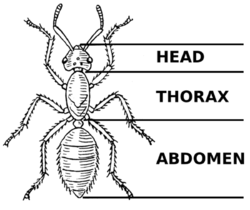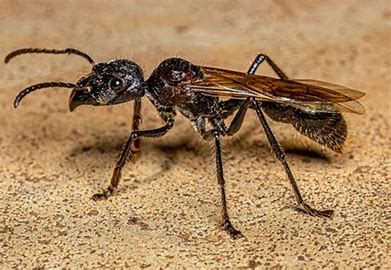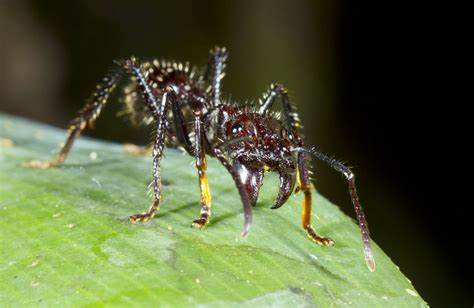Bullet Ant: Difference between revisions
Created page with "right|300px|thumb|Pogonomyrmex barbatus worker. {| class="wikitable" style="text-align:center; float:right; margin-left: 10px; |+ !colspan="2" style="min-width:12em; text-align: center; background-color: rgb(235,235,210)|'''Taxonomic Classification''' |- |- !style="min-width:6em; |Kingdom: |style="min-width:6em; |Animalia |- !style="min-width:6em; |Phylum: |style="min-width:6em; |Arthropoda |- !style..." |
No edit summary |
||
| (27 intermediate revisions by the same user not shown) | |||
| Line 1: | Line 1: | ||
[[File: | [[File:Bullet_ant_1.png]] | ||
{| class="wikitable" style="text-align:center; float:right; margin-left: 10px; | {| class="wikitable" style="text-align:center; float:right; margin-left: 10px; | ||
|+ !colspan="2" style="min-width:12em; text-align: center; background-color: rgb(235,235,210)|'''Taxonomic Classification''' | |+ !colspan="2" style="min-width:12em; text-align: center; background-color: rgb(235,235,210)|'''Taxonomic Classification''' | ||
| Line 24: | Line 24: | ||
|colspan="2"| | |colspan="2"| | ||
|} | |} | ||
The Bullet Ant or ''Paraponera clavata'' is a species of ant that is native to the rainforests of Central and South America. <sup>[5]</sup> Colonies can survive anywhere from 30 days to several months and reach up to 10,000 workers. | The Bullet Ant or ''Paraponera clavata'' is a species of ant that is native to the rainforests of Central and South America. <sup>[5]</sup> Colonies can survive anywhere from 30 days to several months and reach up to 10,000 workers. The Bullet Ant is known for its incredibly powerful and painful sting that is said to be comparable to being shot with a bullet. The Bullet Ant is also known as Hormiga Veinticuatro or 24-hour ant since the pain from the sting can last up to 24 hours. <sup>[1]</sup> | ||
== Anatomy == | == Anatomy == | ||
[[File:HTA.png|250px|thumb|left|Head, thorax, and abdomen.]] | [[File:HTA.png|250px|thumb|left|Head, thorax, and abdomen.]] | ||
The Bullet Ant’s body is divided into three sections; the head, thorax, and abdomen. The ants’ exoskeleton is made of chitin and protects them from the elements and predators. <sup>[1]</sup> Bullet ants are very large with a size ranging between 18 and 30 mm (0.7 to 1.2 in). They are black in color <sup>[4]</sup> | The Bullet Ant’s body is divided into three sections; the head, thorax, and abdomen. The ants’ exoskeleton is made of chitin and protects them from the elements and predators. <sup>[1]</sup> Bullet ants are very large with a size ranging between 18 and 30 mm (0.7 to 1.2 in). They are black in color <sup>[4]</sup> | ||
'''Head''' | '''Head''' | ||
| Line 40: | Line 40: | ||
'''Abdomen''' | '''Abdomen''' | ||
The abdomen contains the ants' vital organs, reproductive parts, and stinger. The acidopore contains formic acid for the ant to emit when it feels threatened. | The abdomen contains the ants' vital organs, reproductive parts, and stinger. The acidopore contains formic acid for the ant to emit when it feels threatened. | ||
== Habitat and Range == | == Habitat and Range == | ||
The Bullet Ant is native to Central, and South America. They construct their nests in the [[soil]], typically at the bases of trees, often those with buttress roots (aerial extensions of lateral surface roots). They can be 1-10 m in diameter with tunnels that extend down to 5 m or more. Bullet Ants will go into the canopy of trees to forage and find food. Colonies can get as big as several hundred ants. In addition, some species clear away all plants and vegetation that surround the outside area of the nest. <sup>[1]</sup> | |||
== Diet and Behavior == | == Diet and Behavior == | ||
[[File: | [[File:Bullet_ant_with_wings.jpg]] | ||
A | A Bullet ant's diet mainly consists of nectar, plant material and small [[arthropods]]. The Bullet Ant workers use their mandibles to collect resources for the nest along with food for themselves. They consider eating smaller foods like nectar and plant material a "snack" while they hunt at night for their big meals. <sup>[3]</sup> | ||
Another behavior of the | Another behavior of the Bullet ant is its defense mechanism, stinging. Although nonaggressive, bullet ants will sting when provoked. When one stings, it releases chemicals that signal other bullet ants in the vicinity to sting repeatedly. The bullet ant has the most painful sting of any insect, according to the Schmidt Pain Index. The pain is described as blinding, electric pain, comparable to being shot with a gun. <sup>[1]</sup> | ||
== Life Cycle == | == Life Cycle == | ||
[[File: | [[File:Bullet_ant_killing_stuff.jpg]] | ||
Bullet Ant reproductive cycles consist of two stages. The Nuptial phase, which occurs once or twice a year. Reproductive males and virgin queens leave their nests in search of mates. And the Mating phase, Female ants set out with male Bullet Ants in large swarms. After mating, both male and female ants lose their wings. Female ants find a place of their own. <sup>[2]</sup> | |||
== References == | == References == | ||
<sup>[1]</sup> | <sup>[1]</sup> https://www.thoughtco.com/bullet-ant-sting-facts-4174296 | ||
<sup>[2]</sup> https://animalhype.com/insects/bullet-ant-facts/ | |||
<sup>[2]</sup> | <sup>[3]</sup> https://www.bestantsuk.com/post/bullet-ants-understanding-their-habitat-and-behaviour | ||
<sup>[3]</sup> | |||
<sup>[4]</sup> Pogonomyrmex. 2019. . https://www.sciencedirect.com/topics/agricultural-and-biological-sciences/pogonomyrmex. | <sup>[4]</sup> Pogonomyrmex. 2019. . https://www.sciencedirect.com/topics/agricultural-and-biological-sciences/pogonomyrmex. | ||
Revision as of 16:37, 30 April 2025
| Kingdom: | Animalia |
|---|---|
| Phylum: | Arthropoda |
| Class: | Insecta |
| Order: | Hymenoptera |
| Family: | Formicidae |
| Genus: | Paraponera |
The Bullet Ant or Paraponera clavata is a species of ant that is native to the rainforests of Central and South America. [5] Colonies can survive anywhere from 30 days to several months and reach up to 10,000 workers. The Bullet Ant is known for its incredibly powerful and painful sting that is said to be comparable to being shot with a bullet. The Bullet Ant is also known as Hormiga Veinticuatro or 24-hour ant since the pain from the sting can last up to 24 hours. [1]
Anatomy

The Bullet Ant’s body is divided into three sections; the head, thorax, and abdomen. The ants’ exoskeleton is made of chitin and protects them from the elements and predators. [1] Bullet ants are very large with a size ranging between 18 and 30 mm (0.7 to 1.2 in). They are black in color [4]
Head
Ants have a set of compound eyes, two antennae, powerful mandibles for carrying, cutting and biting, and maxillary palps to detect scent. [1] Harvester ants have another unique feature; a psammophore. A psammophore is a fringe of hair on the underside of the head that looks like a beard. These “beards” help to excavate nests by acting like a bulldozer. [4]
Thorax
The thorax is the middle segment of the ant and it contains three pairs of legs. The thorax also has a petiole which is the connection between the thorax and the abdomen.
Abdomen
The abdomen contains the ants' vital organs, reproductive parts, and stinger. The acidopore contains formic acid for the ant to emit when it feels threatened.
Habitat and Range
The Bullet Ant is native to Central, and South America. They construct their nests in the soil, typically at the bases of trees, often those with buttress roots (aerial extensions of lateral surface roots). They can be 1-10 m in diameter with tunnels that extend down to 5 m or more. Bullet Ants will go into the canopy of trees to forage and find food. Colonies can get as big as several hundred ants. In addition, some species clear away all plants and vegetation that surround the outside area of the nest. [1]
Diet and Behavior
 A Bullet ant's diet mainly consists of nectar, plant material and small arthropods. The Bullet Ant workers use their mandibles to collect resources for the nest along with food for themselves. They consider eating smaller foods like nectar and plant material a "snack" while they hunt at night for their big meals. [3]
A Bullet ant's diet mainly consists of nectar, plant material and small arthropods. The Bullet Ant workers use their mandibles to collect resources for the nest along with food for themselves. They consider eating smaller foods like nectar and plant material a "snack" while they hunt at night for their big meals. [3]
Another behavior of the Bullet ant is its defense mechanism, stinging. Although nonaggressive, bullet ants will sting when provoked. When one stings, it releases chemicals that signal other bullet ants in the vicinity to sting repeatedly. The bullet ant has the most painful sting of any insect, according to the Schmidt Pain Index. The pain is described as blinding, electric pain, comparable to being shot with a gun. [1]
Life Cycle
 Bullet Ant reproductive cycles consist of two stages. The Nuptial phase, which occurs once or twice a year. Reproductive males and virgin queens leave their nests in search of mates. And the Mating phase, Female ants set out with male Bullet Ants in large swarms. After mating, both male and female ants lose their wings. Female ants find a place of their own. [2]
Bullet Ant reproductive cycles consist of two stages. The Nuptial phase, which occurs once or twice a year. Reproductive males and virgin queens leave their nests in search of mates. And the Mating phase, Female ants set out with male Bullet Ants in large swarms. After mating, both male and female ants lose their wings. Female ants find a place of their own. [2]
References
[1] https://www.thoughtco.com/bullet-ant-sting-facts-4174296 [2] https://animalhype.com/insects/bullet-ant-facts/ [3] https://www.bestantsuk.com/post/bullet-ants-understanding-their-habitat-and-behaviour [4] Pogonomyrmex. 2019. . https://www.sciencedirect.com/topics/agricultural-and-biological-sciences/pogonomyrmex.
